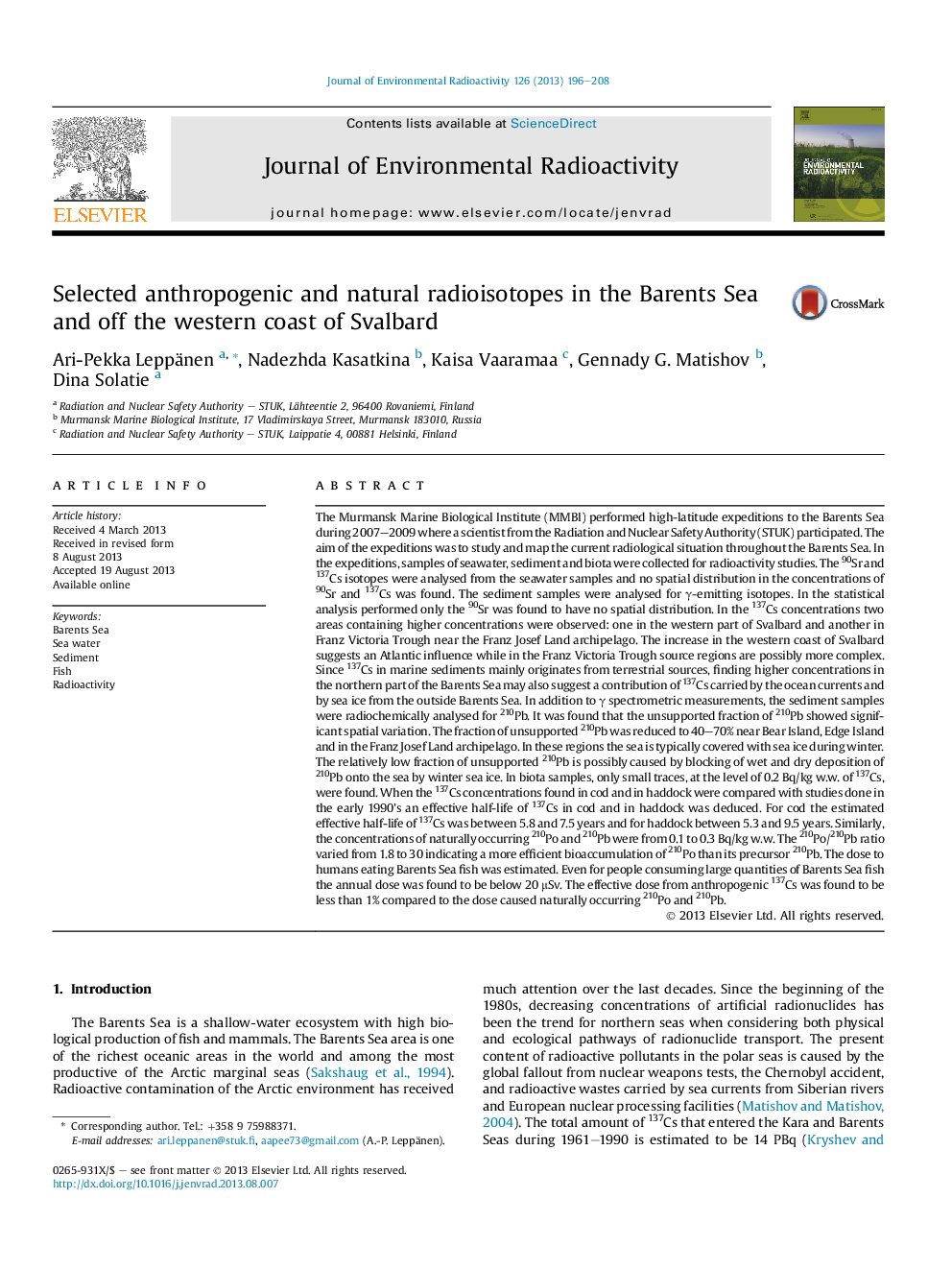| کد مقاله | کد نشریه | سال انتشار | مقاله انگلیسی | نسخه تمام متن |
|---|---|---|---|---|
| 8083317 | 1521607 | 2013 | 13 صفحه PDF | دانلود رایگان |
عنوان انگلیسی مقاله ISI
Selected anthropogenic and natural radioisotopes in the Barents Sea and off the western coast of Svalbard
ترجمه فارسی عنوان
رادیو ایزوتوپ های انسان شناسی و طبیعی در دریای بارنت و خلیج ساحل غربی اسلالبارد
دانلود مقاله + سفارش ترجمه
دانلود مقاله ISI انگلیسی
رایگان برای ایرانیان
کلمات کلیدی
دریای بارنتز، آب دریا، رسوب، ماهی، رادیواکتیویته،
موضوعات مرتبط
مهندسی و علوم پایه
مهندسی انرژی
انرژی هسته ای و مهندسی
چکیده انگلیسی
The Murmansk Marine Biological Institute (MMBI) performed high-latitude expeditions to the Barents Sea during 2007-2009 where a scientist from the Radiation and Nuclear Safety Authority (STUK) participated. The aim of the expeditions was to study and map the current radiological situation throughout the Barents Sea. In the expeditions, samples of seawater, sediment and biota were collected for radioactivity studies. The 90Sr and 137Cs isotopes were analysed from the seawater samples and no spatial distribution in the concentrations of 90Sr and 137Cs was found. The sediment samples were analysed for γ-emitting isotopes. In the statistical analysis performed only the 90Sr was found to have no spatial distribution. In the 137Cs concentrations two areas containing higher concentrations were observed: one in the western part of Svalbard and another in Franz Victoria Trough near the Franz Josef Land archipelago. The increase in the western coast of Svalbard suggests an Atlantic influence while in the Franz Victoria Trough source regions are possibly more complex. Since 137Cs in marine sediments mainly originates from terrestrial sources, finding higher concentrations in the northern part of the Barents Sea may also suggest a contribution of 137Cs carried by the ocean currents and by sea ice from the outside Barents Sea. In addition to γ spectrometric measurements, the sediment samples were radiochemically analysed for 210Pb. It was found that the unsupported fraction of 210Pb showed significant spatial variation. The fraction of unsupported 210Pb was reduced to 40-70% near Bear Island, Edge Island and in the Franz Josef Land archipelago. In these regions the sea is typically covered with sea ice during winter. The relatively low fraction of unsupported 210Pb is possibly caused by blocking of wet and dry deposition of 210Pb onto the sea by winter sea ice. In biota samples, only small traces, at the level of 0.2 Bq/kg w.w. of 137Cs, were found. When the 137Cs concentrations found in cod and in haddock were compared with studies done in the early 1990's an effective half-life of 137Cs in cod and in haddock was deduced. For cod the estimated effective half-life of 137Cs was between 5.8 and 7.5 years and for haddock between 5.3 and 9.5 years. Similarly, the concentrations of naturally occurring 210Po and 210Pb were from 0.1 to 0.3 Bq/kg w.w. The 210Po/210Pb ratio varied from 1.8 to 30 indicating a more efficient bioaccumulation of 210Po than its precursor 210Pb. The dose to humans eating Barents Sea fish was estimated. Even for people consuming large quantities of Barents Sea fish the annual dose was found to be below 20 μSv. The effective dose from anthropogenic 137Cs was found to be less than 1% compared to the dose caused naturally occurring 210Po and 210Pb.
ناشر
Database: Elsevier - ScienceDirect (ساینس دایرکت)
Journal: Journal of Environmental Radioactivity - Volume 126, December 2013, Pages 196-208
Journal: Journal of Environmental Radioactivity - Volume 126, December 2013, Pages 196-208
نویسندگان
Ari-Pekka Leppänen, Nadezhda Kasatkina, Kaisa Vaaramaa, Gennady G. Matishov, Dina Solatie,
